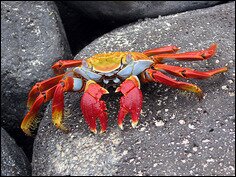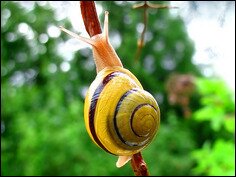What Do People Eat?
Current Category: People.
Food is a great leveler and unifier of people. Everyone needs to eat, and every nation and culture has its own special dishes. The word “company” comes from the Latin for “To break bread with”, and eating together, whether strangers or family, is a good way to forge or strengthen social bonds. Trying dishes unique to a foreign culture, especially if it’s home-cooked, is a great way to break down barriers and to begin to understand people who, on the surface, might seem different.
 Various Native people of Africa.
Various Native people of Africa.
Aboriginals
The Aboriginal people have always stayed close to the land and to nature for their food. The average Aboriginal dinner might seem a bit exotic, consisting of wild honey, yams, water lily and berries. Aboriginals are well known for eating grubs and honey ants, too, although they get most of their protein from kangaroos and smaller animals.
Africans
The foods most commonly eaten all over Africa include yams, watermelon, black-eyes peas, groundnuts and okra. Africans also eat chicken, fish and beef, and like to spice up their meals with garlic, cloves, cardamom and other hot spices. In North Africa, food is influenced by the Middle East, and in the south you’ll see more European influences.
 A grilled steak balsamico, a winner of the National Beef Cook-Off (view the recipe).
A grilled steak balsamico, a winner of the National Beef Cook-Off (view the recipe).
Americans
American cuisine is as varied as the people who make up the population. America has seen wave after wave of immigration, each wave bringing its unique foods with it. You get spicy gumbo stews and chowders from the French-influenced South, and sushi and noodles along the west coast with its big Asian population. Typically American foods include grits, which is a coarse cornmeal porridge, and corndogs, which are Frankfurters dipped in cornmeal paste and deep fried. The Americans are big steak eaters, too!
Astronauts in Space
Food in space isn’t just about staying alive and healthy, you have to think about the effects of crumbs floating around into electrical circuits! During the Apollo missions, the astronauts’ food was packaged into bite-sized cubes so they didn’t have to bite into it and risk crumbs. They had cubes of processed strawberries, beef or cheese sandwiches and date cake. Salt was added to foods already dissolved in water, and pepper was dissolved in oil!
 An Australian icon, the Aussie meat pie. Photo by Guy Bailey (view the recipe).
An Australian icon, the Aussie meat pie. Photo by Guy Bailey (view the recipe).
Australians
Australians like to eat a lot of what the rest of the world would see as barbecue food. They’re fond of red meat and sea food, as well as kangaroo and emu steaks. They like to add native spices and other flavorings to their food, like wattleseed. A wide racial mix in Australia means that foods like noodles, curries and rice dishes are popular as well.
Brazilians
Brazilian food is heavily influenced by Portuguese and African foods, and by far the most popular choice is the rich bean and meat stew called feijoada. The Brazilians like street food as well, and you’ll often see stalls selling deep-fried shrimp balls and chicken croquettes. Breakfasts often involve cheese bread and coffee.
 Ultimate poutine. Photo & recipe by Joshua Bousel (view recipe).
Ultimate poutine. Photo & recipe by Joshua Bousel (view recipe).
Canadians
Canada has a very multicultural society, and Canadians are very fond of going out for lunch and dinner to foreign restaurants, like Mediterranean, Asian and European places. At home, food can often be a more traditional affair, with lots of meat roasts and vegetables. A big favorite, though, it the heart-stopping poutine, a plateful of fries covered in gravy and curd cheese!
Diabetics
Diabetes is a condition in which the body can’t regulate its blood sugar well, or at all. Diet is all-important once someone’s been diagnosed, and the average diabetic person will have to avoid sugary foods and drinks. Fresh vegetables and lots of protein are very helpful, as are wholegrain and brown rice. It seems that coffee is very helpful to diabetics, as long as it’s without sugar!
 Ful medames, Egyptian fava bean stew. Photo & recipe by Karoline Boehm Goodnick (view recipe).
Ful medames, Egyptian fava bean stew. Photo & recipe by Karoline Boehm Goodnick (view recipe).
Egyptians
Egypt’s food is a real hotchpotch of Middle Eastern, African and European influences. Meat is eaten sparingly, with most people’s protein coming from cheese, beans and eggs. Bread is a government-subsidized food, so it’s understandably popular! Rice is a big staple as well, and Egyptians are very fond of fresh fruit.
Germans
Germans are big meat-eaters, and the country is famous for its many different types of sausages. It’s still common in Germany to have white sausages and beer for breakfast! Germans are very fond of heavy sourdough breads, as well as crispbreads and pretzels. Fish, including eels and sardines are very popular, as red cabbage is a common condiment.
 Hawaiian lomi lomi salmon. Photo and recipe by the Food Network (view the recipe).
Hawaiian lomi lomi salmon. Photo and recipe by the Food Network (view the recipe).
Hawaiians
Hawaiian food is as colorful and exotic as the people of Hawaii. The islanders like to feast on local fruits and vegetables, like taro baked in coconut milk, as well as lomi salmon – baked salmon covered in finely chopped vegetables and herbs. Kalua pig is a popular celebration food as well, delicious pork roast with salt and smoke flavoring. Sweet peppers and pineapple are also a must.
Indians
India is a vast continent, with lots of different food traditions – it’s not all curry, though, as many people might think. Many Indians are vegetarian and get their protein from lentils, eggs and cheese. Rice is a major staple, as are chickpeas, which are ground into flour. Indians are big vegetable eaters, even the non-vegetarians, and most Indians love lassi, a delicious yoghurt drink flavored with fruit juice (often mango) and a pinch of salt and pepper.
 Corned beef and cabbage. Photo by Jenbc27. Recipe by Laria Tabul (view the recipe).
Corned beef and cabbage. Photo by Jenbc27. Recipe by Laria Tabul (view the recipe).
Irish People
The Irish are an island people, so fish and seafood is very popular. Everyone associates Ireland with the potato, and colcannon is a tasty side dish made from mashed potato, cream, butter and either cabbage or kale. Stews are very popular in Ireland, and we’ve all heard of Irish stew, a hearty comfort dish made from lamb, carrots and potatoes. Irish soda bread, made with wholewheat, buttermilk and sodium bicarbonate, is a popular export.
Jamaicans
Jamaicans like spicy foods, and jerk chicken is a huge favorite there and all all over the world. Ackee and saltfish, a combination of a strange pod-fruit and salted fish, is also well-known. If you get the chance, try curried goat (it’s never referred to as goat curry!), as it’s addictive.
 Slow-cooker, Mexican pork tacos. Photo by Pillsbury (view recipe).
Slow-cooker, Mexican pork tacos. Photo by Pillsbury (view recipe).
Mexicans
Chili and tortillas, right? Wrong! Most of the Mexican food we see abroad is actually junk or peasant food – burritos, enchiladas and so on. Chili is actually a Texan invention, too! Mole poblano is a popular dish, a bitter and spicy chocolate sauce served with meat and rice. The Mexicans also love seafood and soups, as well as lots of spices and fresh fruit and vegetables. One cliche these guys do stick to, though, is tequila – they love it!
Muslims
Muslims enjoy a wide range of foods, but are forbidden from eating pork or pig products of any kind, as well as from drinking alcohol. Once this is out of the way, Muslims will eat whatever is on offer. Lamb is a particular favorite, as are chicken and rice dishes of varying degrees of spiciness. Herbs and flavorings are very important, too, and a lot of Middle Eastern Muslims will make use of orange flower water and pomegranate molasses. Sumac, a very lemony ground spice is also a popular addition to meat and vegetable dishes.
 Pemmican, a mixture of dried meat, fat, and sometimes dried berries. Pic by , recipe by Jacob Hunter (view the recipe).
Pemmican, a mixture of dried meat, fat, and sometimes dried berries. Pic by , recipe by Jacob Hunter (view the recipe).
Native Americans
The diet of a Native American will depend on where he or she is. Alaskan Indians will eat a lot of fish and muskrat, with berries and other foraged vegetables. More southerly Native Americans did a bit of farming as well as hunting, so supplemented their meat with corn and squash. South American Indians ate a lot of fish, vegetables and small mammals like guinea pigs!
Russians
Everyone known the Russians like hearty, rib-sticking fare, and most Russian foods are based on meats, root vegetables and various sorts of cabbages. Borscht is a well-known soup (or stew) made from beetroot, beef and sour cream. Russia’s cold climate means that grains and seeds like barley and buckwheat grow well, and these are staples. Fresh fruit and vegetables can get scarce, so you’ll often find them pickled. The Russians eat a bit more fat, sugar and dairy than they should, but then they do brave sub-zero temperatures more than the rest of us.
 Paella is a native Spanish dish (view over 15 variety of recipes).
Paella is a native Spanish dish (view over 15 variety of recipes).
Spanish People
The Spanish work the most hours in Europe, and so eat several times throughout the day. Breakfast can be a quick affair, made of fruit juice, pastry and coffee. For an 11.00am snack, the Spanish will eat a filled sandwich of ham, cheese or fish. The Spanish are very fond of seafood and fish, and so their long lunches will consist of three courses offering seasonal vegetables along with squid, chicken or sea fish. Sausages are also popular.
Chinese People
Chinese food isn’t just about enjoyment, it’s about balance and health, so you’ll often find combinations like duck and pineapple – the pineapple helps to digest the meat and “cut through” the grease. Rice and noodles are hugely popular, as are soups – thick and thin. Sichuan food is notoriously spicy, and it’s the most well-known outside China. Sweet and sour is an important taste combination, and deep-frying or pickling foods is very common.
 Goat cheese, fig preserves and prosciutto tartine by Teryi Youngblood (view the recipe).
Goat cheese, fig preserves and prosciutto tartine by Teryi Youngblood (view the recipe).
French People
The French diet is a bit of a mystery – they eat lots of red meat and butter, and drink red wine, but are generally quite healthy. This may be because they eat and drink at the same time, so the alcohol doesn’t hit them so hard, and also helps to counteract the fatty nature of their meals. Breads are popular, as are salads and cheeses. The French are known for their snails, of course, as well as lamb’s brain, but these are not so common now.
Greek People
The Greeks are famous for their use of olive oil, which is no bad thing, but it is very calorific. The Greeks adore big meals with family and friends, and their cuisine is actually very healthy, as they eat a lot of fresh salads, goat cheese and garlic. Oregano and thyme are popular flavorings, and olives are a popular accompaniment. Hummus is hugely popular both in Greece and abroad, as is the classic Greek salad. Lamb and fish are the most popular meats by far, but rabbit and pork aren’t far behind.
 Traditional Japanese sushi with a salmon and avocado filling. Photo: Ben Dearnley. Recipe: Sarah Hobbs (view the recipe).
Traditional Japanese sushi with a salmon and avocado filling. Photo: Ben Dearnley. Recipe: Sarah Hobbs (view the recipe).
Japanese People
Japanese cuisine is amazing! You automatically think of sushi and sashimi, but have you tried yakitori – roast chicken served with a tangy spicy sauce? Noodles are huge in Japan, and soba noodles are a lesser-known variety. Made from buckwheat, they are often eaten cold, and splashed with soy sauce. Dried seaweed is also a favorite ingredient, and the Japanese use it a lot in food art, cutting the dried dark green sheets into shapes to decorate rice balls!
Vegetarians and Vegans
Vegetarians and vegans are quite different. Neither group eats meat, but vegetarians will often eat several foods that are directly produced by animals, like milk, cheese and eggs. Vegans, on the other hand, won’t even eat honey, as it’s “stolen” from bees! A lot of a vegan’s protein comes from pulses and soya, either as tofu, soya mince or soya milk. Many vegetarians eat Quorn, but vegans don’t, as the fibers of the Quorn are bound together by egg. Grains for a large part of the vegetarian and vegan diet, and they often eat the more unusual grains, like buckwheat and quinoa, as these grains have more oils and protein than most other seeds or grains. It’s quite possible to have a full and healthy diet without meat, eggs or dairy, but you need to inform yourself well.












